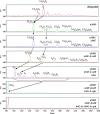Glycosylation Heterogeneity of Hyperglycosylated Recombinant Human Interferon-β (rhIFN-β)
- PMID: 32258897
- PMCID: PMC7114697
- DOI: 10.1021/acsomega.9b04385
Glycosylation Heterogeneity of Hyperglycosylated Recombinant Human Interferon-β (rhIFN-β)
Abstract
We previously developed a biobetter version of rhIFN-β (R27T) that possesses an additional glycosylation site compared with rhIFN-β 1a. Herein, we characterized N-glycosylation heterogeneity of R27T, which includes both N-glycan site occupancy heterogeneity (macro-heterogeneity) and complexity of carbohydrate moieties (micro-heterogeneity). N-glycan site occupancy manifested as distinct differences in size and isoelectric point. The analysis of complex carbohydrate moieties of R27T involved the common biopharmaceutical glycosylation critical quality attributes such as core fucosylation, antennary composition, sialylation, N-acetyllactosamine extensions, linkages, and overall glycan profiles using weak anion-exchange and hydrophilic interaction high-performance liquid chromatography with 2-aminobenzoic acid-labeled N-glycans. The double-glycosylated form accounted for approx. 94% R27T, while the single-glycosylated form accounted for 6% R27T. N-glycans consisted of a mixture of bi-, tri-, and tetra-antennary glycans, some with N-acetyllactosamine extensions, but neither outer arm fucose nor α-galactose was detected. Sialic acid major variants, N-acetyl- and N-glycolyl-neuraminic acid, were more abundant in R27T than in Rebif. The major N-glycan, accounting for ∼42% of total N-glycans, had a di-sialylated, core-fucosylated bi-antennary structure.
Copyright © 2020 American Chemical Society.
Conflict of interest statement
The authors declare the following competing financial interest(s): Kyoung Song and Young Kee Shin currently hold stock and Na Young Kim hold stock options in ABION Inc.
Figures




Similar articles
-
Glycoengineering of interferon-β 1a improves its biophysical and pharmacokinetic properties.PLoS One. 2014 May 23;9(5):e96967. doi: 10.1371/journal.pone.0096967. eCollection 2014. PLoS One. 2014. PMID: 24858932 Free PMC article.
-
N-glycan analysis of human α1-antitrypsin produced in Chinese hamster ovary cells.Glycoconj J. 2013 Jul;30(5):537-47. doi: 10.1007/s10719-012-9453-7. Epub 2012 Oct 12. Glycoconj J. 2013. PMID: 23065139
-
Specific Sialoforms Required for the Immune Suppressive Activity of Human Soluble CD52.Front Immunol. 2019 Aug 27;10:1967. doi: 10.3389/fimmu.2019.01967. eCollection 2019. Front Immunol. 2019. PMID: 31507595 Free PMC article.
-
Glycosylation of site-specific glycans of alpha1-acid glycoprotein and alterations in acute and chronic inflammation.Biochim Biophys Acta. 2005 Aug 30;1725(1):128-35. doi: 10.1016/j.bbagen.2005.03.012. Epub 2005 Apr 7. Biochim Biophys Acta. 2005. PMID: 15863355
-
Identification of highly fucosylated N-linked oligosaccharides from the human parotid gland.Eur J Biochem. 1998 Dec 1;258(2):623-56. doi: 10.1046/j.1432-1327.1998.2580623.x. Eur J Biochem. 1998. PMID: 9874230
Cited by
-
Implications of glycosylation for the development of selected cytokines and their derivatives for medical use.Biotechnol Adv. 2024 Dec;77:108467. doi: 10.1016/j.biotechadv.2024.108467. Epub 2024 Oct 22. Biotechnol Adv. 2024. PMID: 39447666 Free PMC article. Review.
References
-
- Goodin D. S.; Frohman E. M.; Garmany G. P. Jr.; Halper J.; Likosky W. H.; Lublin F. D.; Silberberg D. H.; Stuart W. H.; van den Noort S. Report of the Therapeutics and Technology Assessment Subcommittee of the American Academy of Neurology and the MS Council for Clinical Practice Guidelines. Neurology 2002, 58, 169–178. 10.1212/wnl.58.2.169. - DOI - PubMed
-
- Kappos L.; Freedman M. S.; Polman C. H.; Edan G.; Hartung H.-P.; Miller D. H.; Montalbán X.; Barkhof F.; Radü E.-W.; Bauer L.; Dahms S.; Lanius V.; Pohl C.; Sandbrink R.; Group B. S. Effect of early versus delayed interferon beta-1b treatment on disability after a first clinical event suggestive of multiple sclerosis: a 3-year follow-up analysis of the BENEFIT study. Lancet 2007, 370, 389–397. 10.1016/s0140-6736(07)61194-5. - DOI - PubMed
LinkOut - more resources
Full Text Sources

